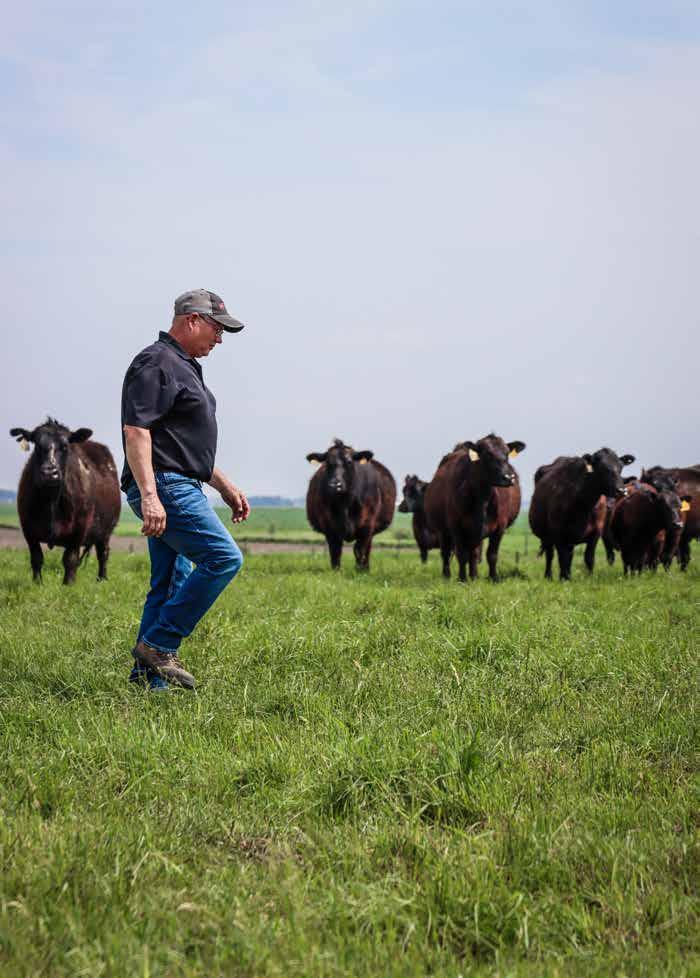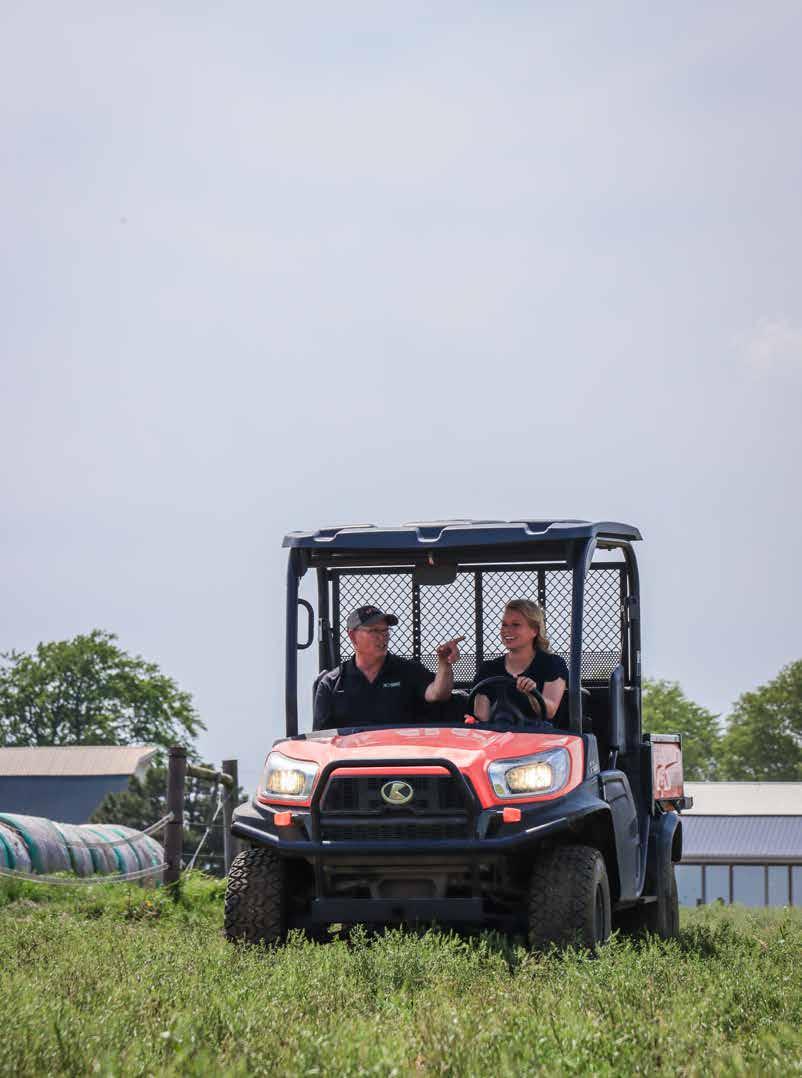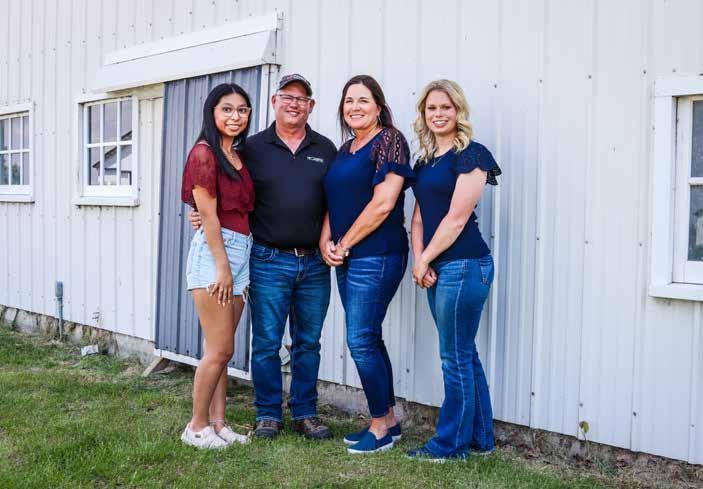
9 minute read
Developing a System
Environmental Steward of the Year winners, Hanson Land and Cattle, take a solutions-focused approach to sustainability.
By Sara McClendon
Doug Hanson, a cattle and grain farmer in Danforth, likes to say that he’s in the business of solving problems. It’s how the 2025 Illinois Beef Association Environmental Stewardship award winner sees his family’s systematic approach to raising cattle and grain in a way that is efficient for their bottom line, good for the soil and beneficial to the livestock. A former agriculture teacher, Doug and his family’s home base is 80 acres of land where his wife Lisa grew up. However, the farm has been part of Doug’s life since the sixth grade, when he and his sister began buying cattle from Lisa’s father.
For a while, Doug and Lisa, both teachers, lived in Monroe County where they had cattle on three different farms. They worked with Lisa’s father, taking bulls back and forth between Monroe and Iroquois County. However, when their daughter Maddie was born, the couple decided that it was time to return to where it all began.
“We thought it was important to come back to where family was,” Doug explains.

Historic Family Roots Lead to Future Innovation
Doug and Lisa’s daughters Maddie and Isabella are fifth generation beef producerss. Doug credits his parents for the family’s involvement in grain farming, and Lisa’s parents for the land to have the cattle like they do today.
“I remind Maddie often that we would have none of this if it weren’t for her grandparents,” Doug says.
Maddie’s grandparents are a core part of her memories of growing up on the farm. She is now an integral part of the family business at Hanson Land and Cattle, but the farm has always been part of her life and her childhood was filled with memories of working with the family and spending time with her grandparents.
“I remember we'd finish up working and grandma would have some lemonade and we'd sit on the swing,” Maddie recalls. “And we would just enjoy it. That was always our summer thing. From the time I can remember, I've helped my dad with moving fences, doing all the rotational grazing, moving cows, sorting calves and putting ear tags in.”
Maddie’s love of cattle started like most young people’s passion – in the showring.
“That was always something that my dad and I loved to do,” Maddie says of showing cattle. “That was where we spent all of our time, and it was truly just so much fun. And now we also get to raise show cattle. So not only do we get to do that together, but we also get to kind of, in a way give back. We get to then help other young 4H or FFA kids get started and find their love for showing cattle.”
Maddie leads the retail side of the operation, with customers from neighboring counties and as far as Chicago. Their customers appreciate the transparency of their operation and the knowledge that the meat they purchase has been thoughtfully raised by the Hanson family.
“A lot of our customers love knowing that the beef is solely coming from Hanson Land and Cattle,” Maddie says. “They like knowing the cattle are on pastures. They like seeing like the pictures on Facebook. They like the little baby calves out in the pasture.”
Maddie’s drive to share her love of agriculture comes from her father.
“He was the one always pushing me to do contests, pushing me to just get involved and just be the best person that I can be,” Maddie says. “He encouraged me to just go out and have fun, work hard and promote the beef and ag business.”
Sharing passion and knowledge is something Doug continues to this day on his operation and in job with Pro Harvest Seeds where for two decades he has worked with producers to find the right system for their operation that keeps the environment and their bottom line in mind.
Doing What’s Best Pays Off
Lisa’s family’s farm was mostly a grain farm, aside from about 8 acres. About 20 years ago, the family went through the USDA’s Environmental Quality Incentives Program (EQIP) and installed 22,000 feet of fence. The operation features 16 paddocks, all with water.
There is also a winter-feeding station, which is similar to a large pavilion, that allows the cows to come up and eat in the wintertime. It provides several benefits to the operation. In addition to providing a place for cattle to eat when it is too wet to graze, it also allows for the collection of manure to use in the grain operation which provides positive benefits to the nutrient management program of the corn, soybean and wheat fields. Plus, it helps mitigate disease risk by having cattle graze over top of where manure was applied.
As far back as Doug’s high school days, he’s been concerned with environmental stewardship in agriculture. He recalls a FFA speech about T by 2000, the Illinois Erosion and Sediment Control law focused on soil health. During his time as an educator and then in his job with Pro Harvest Seeds, that interest has expanded into an educational platform for other livestock producers in the state.
The guiding principle of the Hanson Land and Cattle is looking beyond just the property line to develop mutually beneficial systems. One such system is the use of cover crops.
Twenty years ago, Doug began putting on programs for producers about pasture management. Five years in, the discussion began to incorporate cover crops as a feed. The interest in this management practice caught on fast.
“All of a sudden corn, soybean producers started showing up,” Doug says, “They would sit through cattle information just to get cover crop information.”
Eventually, they began splitting out parts of the program dedicated to all the benefits of cover crops as feed for livestock producers and soil health for corn and soybean growers. Most of the sustainable practices that Doug shares with producers started on his own farm.
“What we learned, actually on this farm for the most part, and through going to a lot of events and a lot of other farms, is that if a cover crop is good for the soil, then it's good for the animal,” Doug explains. “And anything that's good for the animal is good for the soil usually. That's a simultaneous benefit.”
With proof of a solution on his own farm, Doug was able work with producers to develop programs and systems for their own operations to take advantage of these mutual thatbenefits. As the practice continued to gain momentum, Doug’s message expanded and he realized the full potential of sharing this sustainability practice with producers.
One major moment in this journey came when Doug had the opportunity to speak at a meeting for the National Cover Crop Foundation. He was one of four speakers chosen for the occasion. A cover crop expert from Colorado stuck around to hear about his program because he was so intrigued by its success.
“That was actually a turning point that made me realize that there is a demand,” Doug says. “I already had that education background and I was already putting on forage programs, but it showed me that there are people who could really benefit from having livestock tied in with cover crops that weren't considering it.”
While cover crops are a no-brainer for Doug, with a lifelong experience in the cattle industry, he knows that producers need to find the system that works best for their unique operation.
“It’s not whether cover crops are right or wrong, it's what problems are we trying to solve?” Doug explains. “In order for cover crops be successful, you have to get the system that works best for your farm.”
Growing as Family and a Business
Cover crops are an important part of the Hanson Land and Cattle system, but it goes beyond any single sustainability practice. Doug says the key is to understand and plan in advance for solutions to what nature might throw your way.
Doug says, "in this part of the world, you might get too much rain and then not enough, and all in the same month. I have learned that you just have to be prepared for that.”
The family is also realistic about their goals for growth. They understand that just because they want to continue to expand doesn’t always mean the operation is ready for that. However, just as the family farm has transformed over Doug and Lisa’s life, the business continues to adapt.
One positive growth for the family farm was when Maddie’s husband Joseph quickly became a major part of the operation.
“Joe’s job is to identify when we take an animal from 500 pounds or 800 pounds, how we can do it most efficiently,” Doug says.
Joseph grew up on a row crop operation, then in college worked at an internship in DeKalb County for a custom feeder. This insight has helped the business grow, especially as the family continues to expand the retail portion of its operation.
“I brought the ability to see the finished side of cattle,” Joseph says. “I've brought back a lot of the treatment side of things. Noticing what to do for cattle and the kind of care that is required.”
As the business continues to grow, adapt and change, one thing has stayed the same since the time Doug would visit as a kid: Family works together to get the job done.
“It's truly a family business,” Doug says. “And, boy, that's the ag world. It always has been. I think that's why there's so much passion in this.”




